System Analysis Assignment: Data Analysis, Use Cases, and Functions
VerifiedAdded on 2020/03/02
|12
|2129
|167
Homework Assignment
AI Summary
This assignment provides a comprehensive analysis of system analysis concepts, encompassing definitions, diagrams, and practical applications. It begins with defining system analysis and the System Development Life Cycle (SDLC), followed by detailed explanations of UML diagrams, including class diagrams, use case diagrams, and activity diagrams, illustrating their usage within the SDLC. The assignment explores use case diagrams and their components, along with definitions of requirements, functional and non-functional requirements, and the challenges associated with stakeholder management. It delves into stakeholder interview considerations, the relationship between use case and class diagrams, and the benefits of vendor research. The solution also addresses strategies for managing project scope, analyzing data, and creating use cases, including input and output descriptions for various functions. The assignment concludes with a list of references.

Student details
Student nme
Student nme
Paraphrase This Document
Need a fresh take? Get an instant paraphrase of this document with our AI Paraphraser

Question 1
System analysis is the process of the business process of an organization in order to identify the goals
and the main purpose of the business to create a system that will help achieve them in an efficient way
(Satzinger, Jackson and Burd, 2012). System analysis can also be defined as the process of breaking
down a system into components and studying how the components integrate and work together to
form the complete system (Subramanian, 2000).
Question 2
System development life cycle (SDLC) is the process through which an information system is created
from scratch up to when it’s finished. SDLC involves planning, creating, testing and deploying the
information system. It’s also referred to as application development life cycle.
Question 3
UML Diagram Definition Where Used in SDLC?
Class Diagram A class diagram is a diagram that is
used to show the static structure of a
system by showing the classes of a
system, the attributes that define the
classes, the relationships between
the classes and the operations or
methods belonging to the classes.
This diagram is used in
modelling of objected
oriented systems to show
the structure os a system
by breaking it down into
classes.
Use Case Diagram A use case diagram is a diagram used
in system analysis to depict how
different elements interact with a
system.
This diagram is used to
show actors of a system
and their intreactions with
the system
Activity Diagram An activity diagram is diagram used
in system analysis to model
computational processes of an
information system and the
organizational workflows of an
organization.
This diagram is sued to
show the workflow of the
system
Architectural
Configuration Diagram
This is a diagram used in system
analysis to describe the architecture
of a software system by showing
groups of components making the
system, their connections and how
they interact.
This diagram to show the
behavior of a system by
showing internal and
external elements of the
system
Design Class Diagram A design class diagram is a diagram This diagram is used to
System analysis is the process of the business process of an organization in order to identify the goals
and the main purpose of the business to create a system that will help achieve them in an efficient way
(Satzinger, Jackson and Burd, 2012). System analysis can also be defined as the process of breaking
down a system into components and studying how the components integrate and work together to
form the complete system (Subramanian, 2000).
Question 2
System development life cycle (SDLC) is the process through which an information system is created
from scratch up to when it’s finished. SDLC involves planning, creating, testing and deploying the
information system. It’s also referred to as application development life cycle.
Question 3
UML Diagram Definition Where Used in SDLC?
Class Diagram A class diagram is a diagram that is
used to show the static structure of a
system by showing the classes of a
system, the attributes that define the
classes, the relationships between
the classes and the operations or
methods belonging to the classes.
This diagram is used in
modelling of objected
oriented systems to show
the structure os a system
by breaking it down into
classes.
Use Case Diagram A use case diagram is a diagram used
in system analysis to depict how
different elements interact with a
system.
This diagram is used to
show actors of a system
and their intreactions with
the system
Activity Diagram An activity diagram is diagram used
in system analysis to model
computational processes of an
information system and the
organizational workflows of an
organization.
This diagram is sued to
show the workflow of the
system
Architectural
Configuration Diagram
This is a diagram used in system
analysis to describe the architecture
of a software system by showing
groups of components making the
system, their connections and how
they interact.
This diagram to show the
behavior of a system by
showing internal and
external elements of the
system
Design Class Diagram A design class diagram is a diagram This diagram is used to
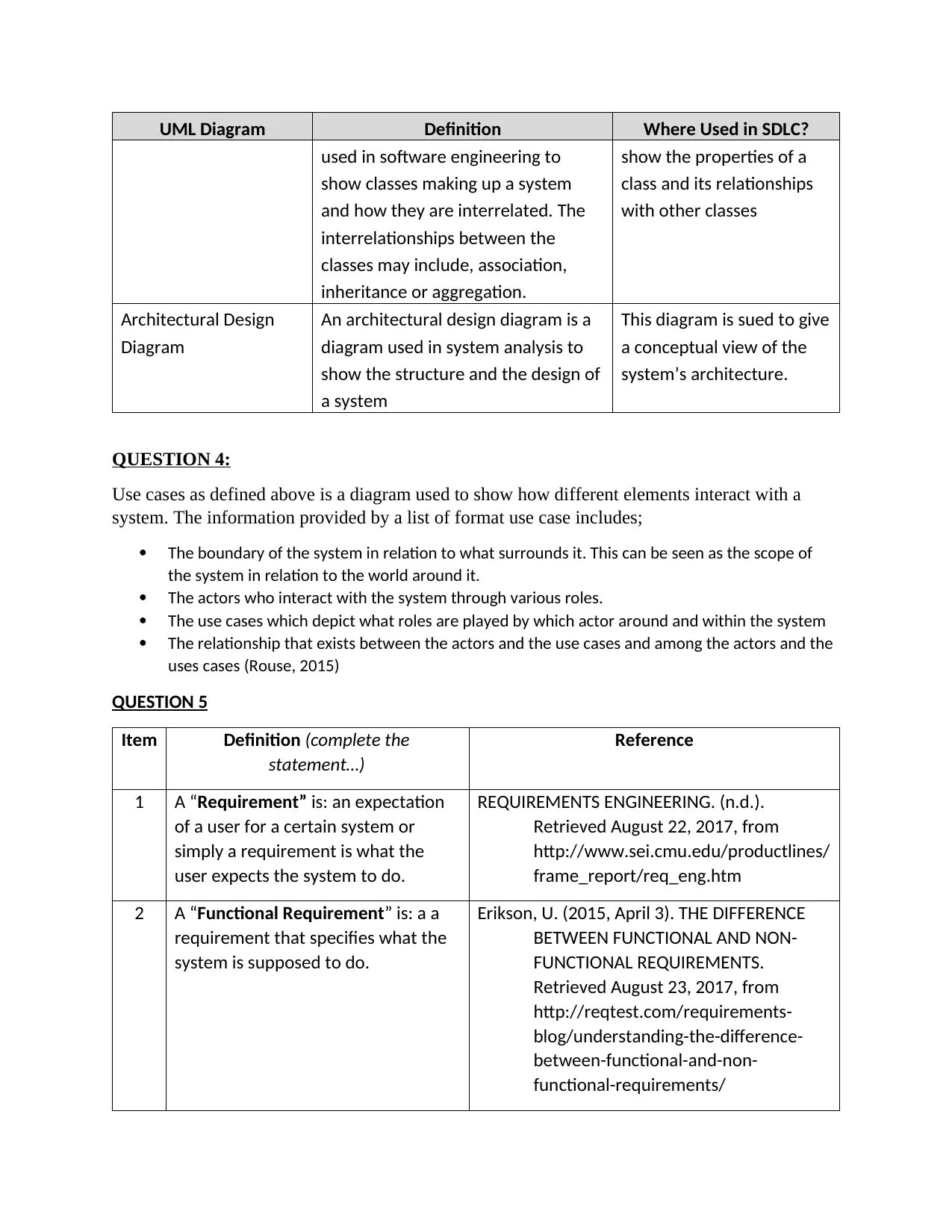
UML Diagram Definition Where Used in SDLC?
used in software engineering to
show classes making up a system
and how they are interrelated. The
interrelationships between the
classes may include, association,
inheritance or aggregation.
show the properties of a
class and its relationships
with other classes
Architectural Design
Diagram
An architectural design diagram is a
diagram used in system analysis to
show the structure and the design of
a system
This diagram is sued to give
a conceptual view of the
system’s architecture.
QUESTION 4:
Use cases as defined above is a diagram used to show how different elements interact with a
system. The information provided by a list of format use case includes;
The boundary of the system in relation to what surrounds it. This can be seen as the scope of
the system in relation to the world around it.
The actors who interact with the system through various roles.
The use cases which depict what roles are played by which actor around and within the system
The relationship that exists between the actors and the use cases and among the actors and the
uses cases (Rouse, 2015)
QUESTION 5
Item Definition (complete the
statement…)
Reference
1 A “Requirement” is: an expectation
of a user for a certain system or
simply a requirement is what the
user expects the system to do.
REQUIREMENTS ENGINEERING. (n.d.).
Retrieved August 22, 2017, from
http://www.sei.cmu.edu/productlines/
frame_report/req_eng.htm
2 A “Functional Requirement” is: a a
requirement that specifies what the
system is supposed to do.
Erikson, U. (2015, April 3). THE DIFFERENCE
BETWEEN FUNCTIONAL AND NON-
FUNCTIONAL REQUIREMENTS.
Retrieved August 23, 2017, from
http://reqtest.com/requirements-
blog/understanding-the-difference-
between-functional-and-non-
functional-requirements/
used in software engineering to
show classes making up a system
and how they are interrelated. The
interrelationships between the
classes may include, association,
inheritance or aggregation.
show the properties of a
class and its relationships
with other classes
Architectural Design
Diagram
An architectural design diagram is a
diagram used in system analysis to
show the structure and the design of
a system
This diagram is sued to give
a conceptual view of the
system’s architecture.
QUESTION 4:
Use cases as defined above is a diagram used to show how different elements interact with a
system. The information provided by a list of format use case includes;
The boundary of the system in relation to what surrounds it. This can be seen as the scope of
the system in relation to the world around it.
The actors who interact with the system through various roles.
The use cases which depict what roles are played by which actor around and within the system
The relationship that exists between the actors and the use cases and among the actors and the
uses cases (Rouse, 2015)
QUESTION 5
Item Definition (complete the
statement…)
Reference
1 A “Requirement” is: an expectation
of a user for a certain system or
simply a requirement is what the
user expects the system to do.
REQUIREMENTS ENGINEERING. (n.d.).
Retrieved August 22, 2017, from
http://www.sei.cmu.edu/productlines/
frame_report/req_eng.htm
2 A “Functional Requirement” is: a a
requirement that specifies what the
system is supposed to do.
Erikson, U. (2015, April 3). THE DIFFERENCE
BETWEEN FUNCTIONAL AND NON-
FUNCTIONAL REQUIREMENTS.
Retrieved August 23, 2017, from
http://reqtest.com/requirements-
blog/understanding-the-difference-
between-functional-and-non-
functional-requirements/
⊘ This is a preview!⊘
Do you want full access?
Subscribe today to unlock all pages.

Trusted by 1+ million students worldwide
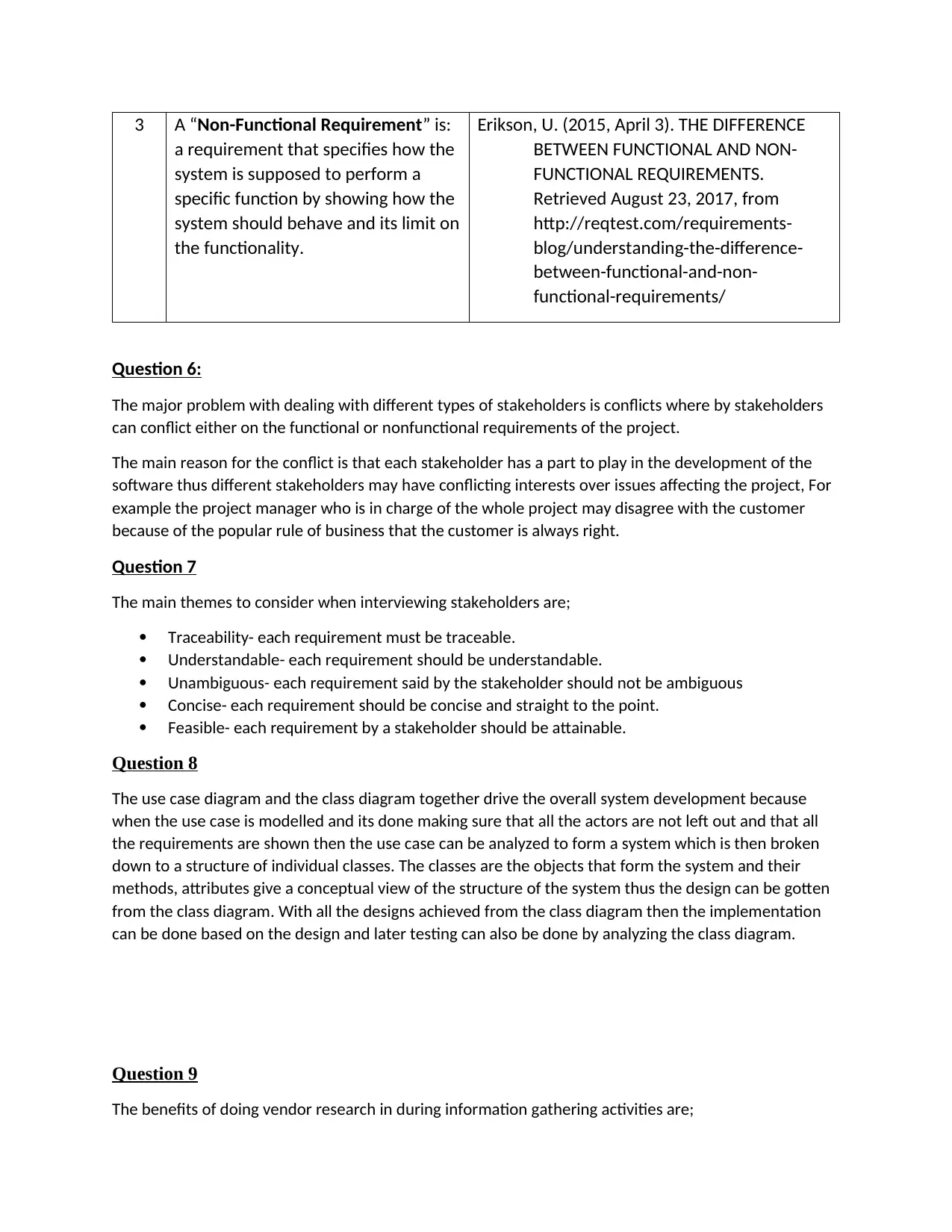
3 A “Non-Functional Requirement” is:
a requirement that specifies how the
system is supposed to perform a
specific function by showing how the
system should behave and its limit on
the functionality.
Erikson, U. (2015, April 3). THE DIFFERENCE
BETWEEN FUNCTIONAL AND NON-
FUNCTIONAL REQUIREMENTS.
Retrieved August 23, 2017, from
http://reqtest.com/requirements-
blog/understanding-the-difference-
between-functional-and-non-
functional-requirements/
Question 6:
The major problem with dealing with different types of stakeholders is conflicts where by stakeholders
can conflict either on the functional or nonfunctional requirements of the project.
The main reason for the conflict is that each stakeholder has a part to play in the development of the
software thus different stakeholders may have conflicting interests over issues affecting the project, For
example the project manager who is in charge of the whole project may disagree with the customer
because of the popular rule of business that the customer is always right.
Question 7
The main themes to consider when interviewing stakeholders are;
Traceability- each requirement must be traceable.
Understandable- each requirement should be understandable.
Unambiguous- each requirement said by the stakeholder should not be ambiguous
Concise- each requirement should be concise and straight to the point.
Feasible- each requirement by a stakeholder should be attainable.
Question 8
The use case diagram and the class diagram together drive the overall system development because
when the use case is modelled and its done making sure that all the actors are not left out and that all
the requirements are shown then the use case can be analyzed to form a system which is then broken
down to a structure of individual classes. The classes are the objects that form the system and their
methods, attributes give a conceptual view of the structure of the system thus the design can be gotten
from the class diagram. With all the designs achieved from the class diagram then the implementation
can be done based on the design and later testing can also be done by analyzing the class diagram.
Question 9
The benefits of doing vendor research in during information gathering activities are;
a requirement that specifies how the
system is supposed to perform a
specific function by showing how the
system should behave and its limit on
the functionality.
Erikson, U. (2015, April 3). THE DIFFERENCE
BETWEEN FUNCTIONAL AND NON-
FUNCTIONAL REQUIREMENTS.
Retrieved August 23, 2017, from
http://reqtest.com/requirements-
blog/understanding-the-difference-
between-functional-and-non-
functional-requirements/
Question 6:
The major problem with dealing with different types of stakeholders is conflicts where by stakeholders
can conflict either on the functional or nonfunctional requirements of the project.
The main reason for the conflict is that each stakeholder has a part to play in the development of the
software thus different stakeholders may have conflicting interests over issues affecting the project, For
example the project manager who is in charge of the whole project may disagree with the customer
because of the popular rule of business that the customer is always right.
Question 7
The main themes to consider when interviewing stakeholders are;
Traceability- each requirement must be traceable.
Understandable- each requirement should be understandable.
Unambiguous- each requirement said by the stakeholder should not be ambiguous
Concise- each requirement should be concise and straight to the point.
Feasible- each requirement by a stakeholder should be attainable.
Question 8
The use case diagram and the class diagram together drive the overall system development because
when the use case is modelled and its done making sure that all the actors are not left out and that all
the requirements are shown then the use case can be analyzed to form a system which is then broken
down to a structure of individual classes. The classes are the objects that form the system and their
methods, attributes give a conceptual view of the structure of the system thus the design can be gotten
from the class diagram. With all the designs achieved from the class diagram then the implementation
can be done based on the design and later testing can also be done by analyzing the class diagram.
Question 9
The benefits of doing vendor research in during information gathering activities are;
Paraphrase This Document
Need a fresh take? Get an instant paraphrase of this document with our AI Paraphraser
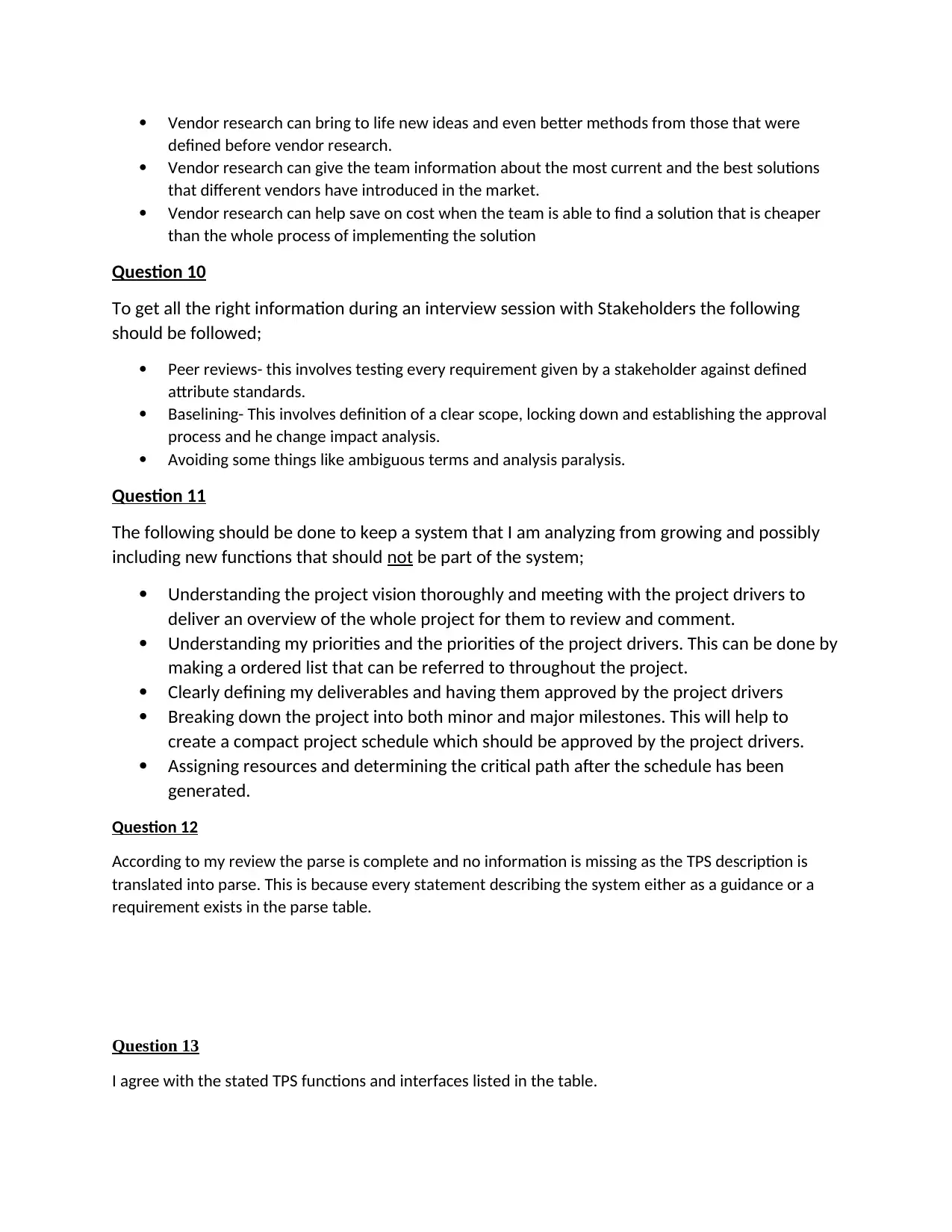
Vendor research can bring to life new ideas and even better methods from those that were
defined before vendor research.
Vendor research can give the team information about the most current and the best solutions
that different vendors have introduced in the market.
Vendor research can help save on cost when the team is able to find a solution that is cheaper
than the whole process of implementing the solution
Question 10
To get all the right information during an interview session with Stakeholders the following
should be followed;
Peer reviews- this involves testing every requirement given by a stakeholder against defined
attribute standards.
Baselining- This involves definition of a clear scope, locking down and establishing the approval
process and he change impact analysis.
Avoiding some things like ambiguous terms and analysis paralysis.
Question 11
The following should be done to keep a system that I am analyzing from growing and possibly
including new functions that should not be part of the system;
Understanding the project vision thoroughly and meeting with the project drivers to
deliver an overview of the whole project for them to review and comment.
Understanding my priorities and the priorities of the project drivers. This can be done by
making a ordered list that can be referred to throughout the project.
Clearly defining my deliverables and having them approved by the project drivers
Breaking down the project into both minor and major milestones. This will help to
create a compact project schedule which should be approved by the project drivers.
Assigning resources and determining the critical path after the schedule has been
generated.
Question 12
According to my review the parse is complete and no information is missing as the TPS description is
translated into parse. This is because every statement describing the system either as a guidance or a
requirement exists in the parse table.
Question 13
I agree with the stated TPS functions and interfaces listed in the table.
defined before vendor research.
Vendor research can give the team information about the most current and the best solutions
that different vendors have introduced in the market.
Vendor research can help save on cost when the team is able to find a solution that is cheaper
than the whole process of implementing the solution
Question 10
To get all the right information during an interview session with Stakeholders the following
should be followed;
Peer reviews- this involves testing every requirement given by a stakeholder against defined
attribute standards.
Baselining- This involves definition of a clear scope, locking down and establishing the approval
process and he change impact analysis.
Avoiding some things like ambiguous terms and analysis paralysis.
Question 11
The following should be done to keep a system that I am analyzing from growing and possibly
including new functions that should not be part of the system;
Understanding the project vision thoroughly and meeting with the project drivers to
deliver an overview of the whole project for them to review and comment.
Understanding my priorities and the priorities of the project drivers. This can be done by
making a ordered list that can be referred to throughout the project.
Clearly defining my deliverables and having them approved by the project drivers
Breaking down the project into both minor and major milestones. This will help to
create a compact project schedule which should be approved by the project drivers.
Assigning resources and determining the critical path after the schedule has been
generated.
Question 12
According to my review the parse is complete and no information is missing as the TPS description is
translated into parse. This is because every statement describing the system either as a guidance or a
requirement exists in the parse table.
Question 13
I agree with the stated TPS functions and interfaces listed in the table.
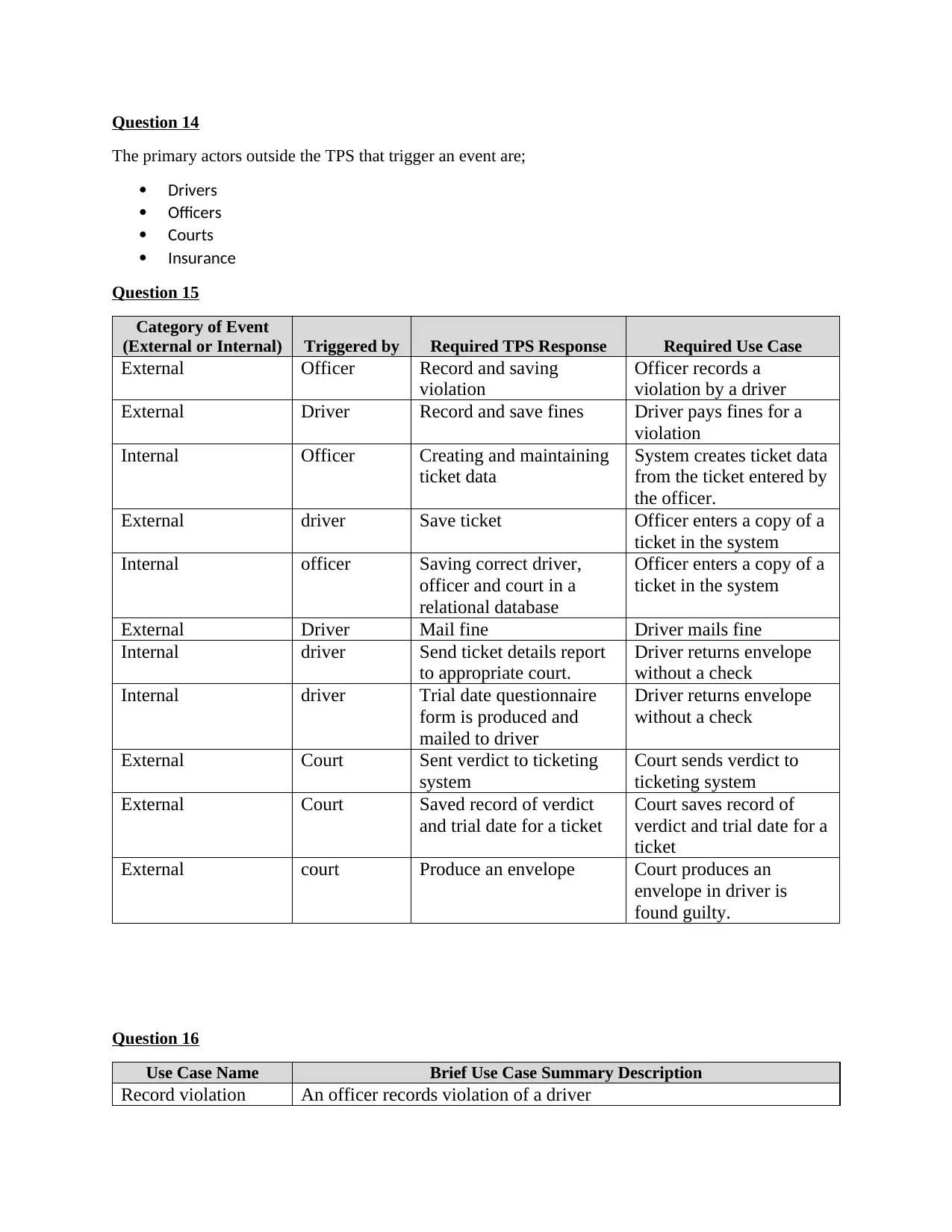
Question 14
The primary actors outside the TPS that trigger an event are;
Drivers
Officers
Courts
Insurance
Question 15
Category of Event
(External or Internal) Triggered by Required TPS Response Required Use Case
External Officer Record and saving
violation
Officer records a
violation by a driver
External Driver Record and save fines Driver pays fines for a
violation
Internal Officer Creating and maintaining
ticket data
System creates ticket data
from the ticket entered by
the officer.
External driver Save ticket Officer enters a copy of a
ticket in the system
Internal officer Saving correct driver,
officer and court in a
relational database
Officer enters a copy of a
ticket in the system
External Driver Mail fine Driver mails fine
Internal driver Send ticket details report
to appropriate court.
Driver returns envelope
without a check
Internal driver Trial date questionnaire
form is produced and
mailed to driver
Driver returns envelope
without a check
External Court Sent verdict to ticketing
system
Court sends verdict to
ticketing system
External Court Saved record of verdict
and trial date for a ticket
Court saves record of
verdict and trial date for a
ticket
External court Produce an envelope Court produces an
envelope in driver is
found guilty.
Question 16
Use Case Name Brief Use Case Summary Description
Record violation An officer records violation of a driver
The primary actors outside the TPS that trigger an event are;
Drivers
Officers
Courts
Insurance
Question 15
Category of Event
(External or Internal) Triggered by Required TPS Response Required Use Case
External Officer Record and saving
violation
Officer records a
violation by a driver
External Driver Record and save fines Driver pays fines for a
violation
Internal Officer Creating and maintaining
ticket data
System creates ticket data
from the ticket entered by
the officer.
External driver Save ticket Officer enters a copy of a
ticket in the system
Internal officer Saving correct driver,
officer and court in a
relational database
Officer enters a copy of a
ticket in the system
External Driver Mail fine Driver mails fine
Internal driver Send ticket details report
to appropriate court.
Driver returns envelope
without a check
Internal driver Trial date questionnaire
form is produced and
mailed to driver
Driver returns envelope
without a check
External Court Sent verdict to ticketing
system
Court sends verdict to
ticketing system
External Court Saved record of verdict
and trial date for a ticket
Court saves record of
verdict and trial date for a
ticket
External court Produce an envelope Court produces an
envelope in driver is
found guilty.
Question 16
Use Case Name Brief Use Case Summary Description
Record violation An officer records violation of a driver
⊘ This is a preview!⊘
Do you want full access?
Subscribe today to unlock all pages.

Trusted by 1+ million students worldwide

pay fine An driver who has pleaded guilty or has been proven guilty records a
fine
Create ticket data An officer enters a ticket and the system creates ticket data
Save ticket Copy of the ticket is entered back to the system
Save officer, ticket
and court in the db.
Copy of the ticket is entered back to the system
Mail fine A driver mails a fine for a certain ticket
Send ticket details to
appropriate court
If a driver return an envelope without a check the system is supposed
to send ticket details to the appropriate court.
Produce trial date
questionnaire
System produces a trial date questionnaire after sending ticket details
to the court.
Mail driver System mails driver the trial data questionnaire after producing the
form.
Send verdict to
ticketing system
A court sends a verdict to the ticketing system after a trial
Save verdict record System saves a record of the verdict after the verdict is sent to the
ticketing system
Produce an envelope Court produces an envelope for a guilty driver.
Question 17
Input Description Data Elements Input Destination
1 Violation adding interface Ticket number,
location, ticket type,
ticket, date, ticket
time, plea, trial date,
verdict, fine amount,
date paid
Ticket data table
2 Fine sending interface Fine amount Ticket data table
3 Trial date questionnaire interface Trial questionnaire Mailing function
4 Verdict sending interface verdict Ticket data table
5 Verdict saved verdict Ticket data table
Question 18
Driver data
fine
Create ticket data An officer enters a ticket and the system creates ticket data
Save ticket Copy of the ticket is entered back to the system
Save officer, ticket
and court in the db.
Copy of the ticket is entered back to the system
Mail fine A driver mails a fine for a certain ticket
Send ticket details to
appropriate court
If a driver return an envelope without a check the system is supposed
to send ticket details to the appropriate court.
Produce trial date
questionnaire
System produces a trial date questionnaire after sending ticket details
to the court.
Mail driver System mails driver the trial data questionnaire after producing the
form.
Send verdict to
ticketing system
A court sends a verdict to the ticketing system after a trial
Save verdict record System saves a record of the verdict after the verdict is sent to the
ticketing system
Produce an envelope Court produces an envelope for a guilty driver.
Question 17
Input Description Data Elements Input Destination
1 Violation adding interface Ticket number,
location, ticket type,
ticket, date, ticket
time, plea, trial date,
verdict, fine amount,
date paid
Ticket data table
2 Fine sending interface Fine amount Ticket data table
3 Trial date questionnaire interface Trial questionnaire Mailing function
4 Verdict sending interface verdict Ticket data table
5 Verdict saved verdict Ticket data table
Question 18
Driver data
Paraphrase This Document
Need a fresh take? Get an instant paraphrase of this document with our AI Paraphraser
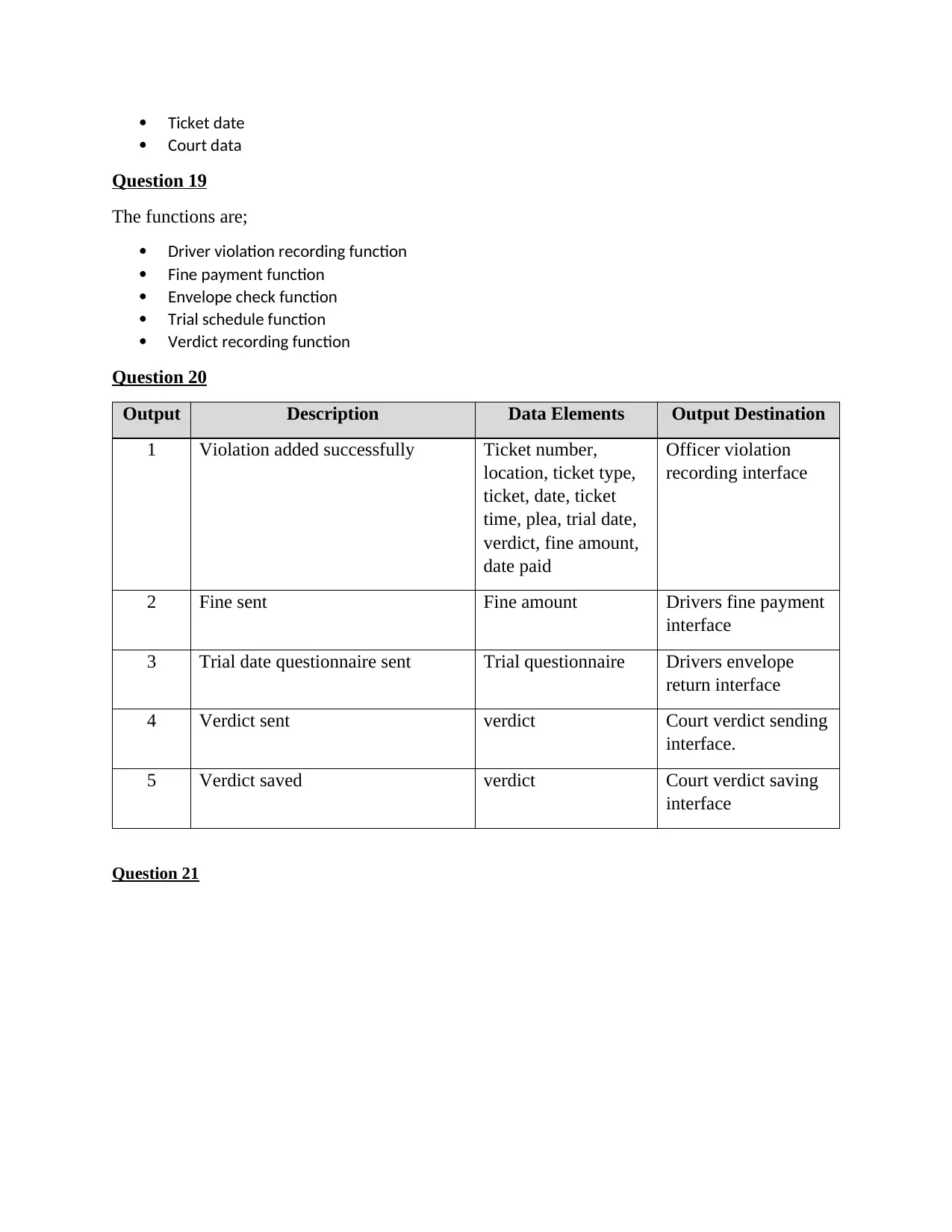
Ticket date
Court data
Question 19
The functions are;
Driver violation recording function
Fine payment function
Envelope check function
Trial schedule function
Verdict recording function
Question 20
Output Description Data Elements Output Destination
1 Violation added successfully Ticket number,
location, ticket type,
ticket, date, ticket
time, plea, trial date,
verdict, fine amount,
date paid
Officer violation
recording interface
2 Fine sent Fine amount Drivers fine payment
interface
3 Trial date questionnaire sent Trial questionnaire Drivers envelope
return interface
4 Verdict sent verdict Court verdict sending
interface.
5 Verdict saved verdict Court verdict saving
interface
Question 21
Court data
Question 19
The functions are;
Driver violation recording function
Fine payment function
Envelope check function
Trial schedule function
Verdict recording function
Question 20
Output Description Data Elements Output Destination
1 Violation added successfully Ticket number,
location, ticket type,
ticket, date, ticket
time, plea, trial date,
verdict, fine amount,
date paid
Officer violation
recording interface
2 Fine sent Fine amount Drivers fine payment
interface
3 Trial date questionnaire sent Trial questionnaire Drivers envelope
return interface
4 Verdict sent verdict Court verdict sending
interface.
5 Verdict saved verdict Court verdict saving
interface
Question 21
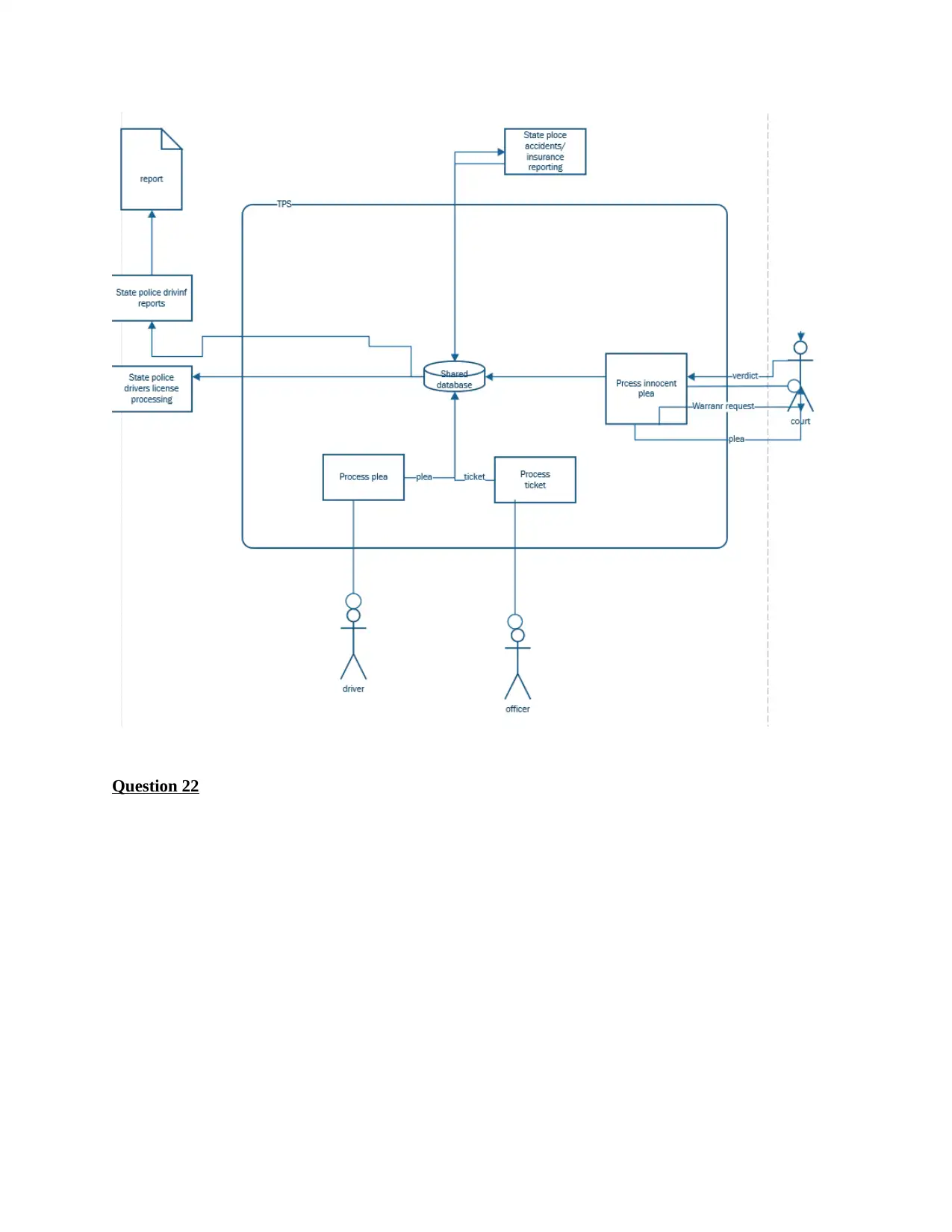
Question 22
⊘ This is a preview!⊘
Do you want full access?
Subscribe today to unlock all pages.

Trusted by 1+ million students worldwide
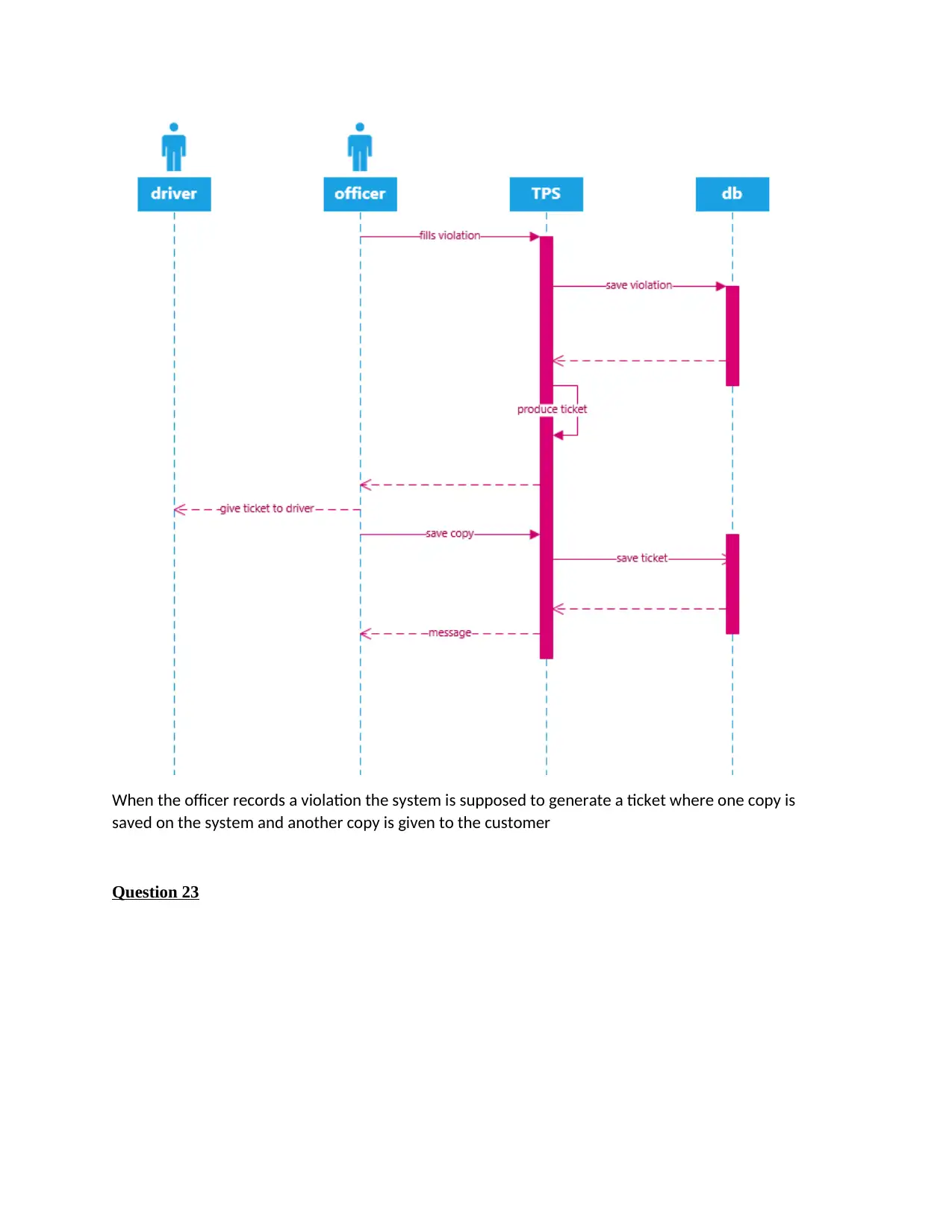
When the officer records a violation the system is supposed to generate a ticket where one copy is
saved on the system and another copy is given to the customer
Question 23
saved on the system and another copy is given to the customer
Question 23
Paraphrase This Document
Need a fresh take? Get an instant paraphrase of this document with our AI Paraphraser
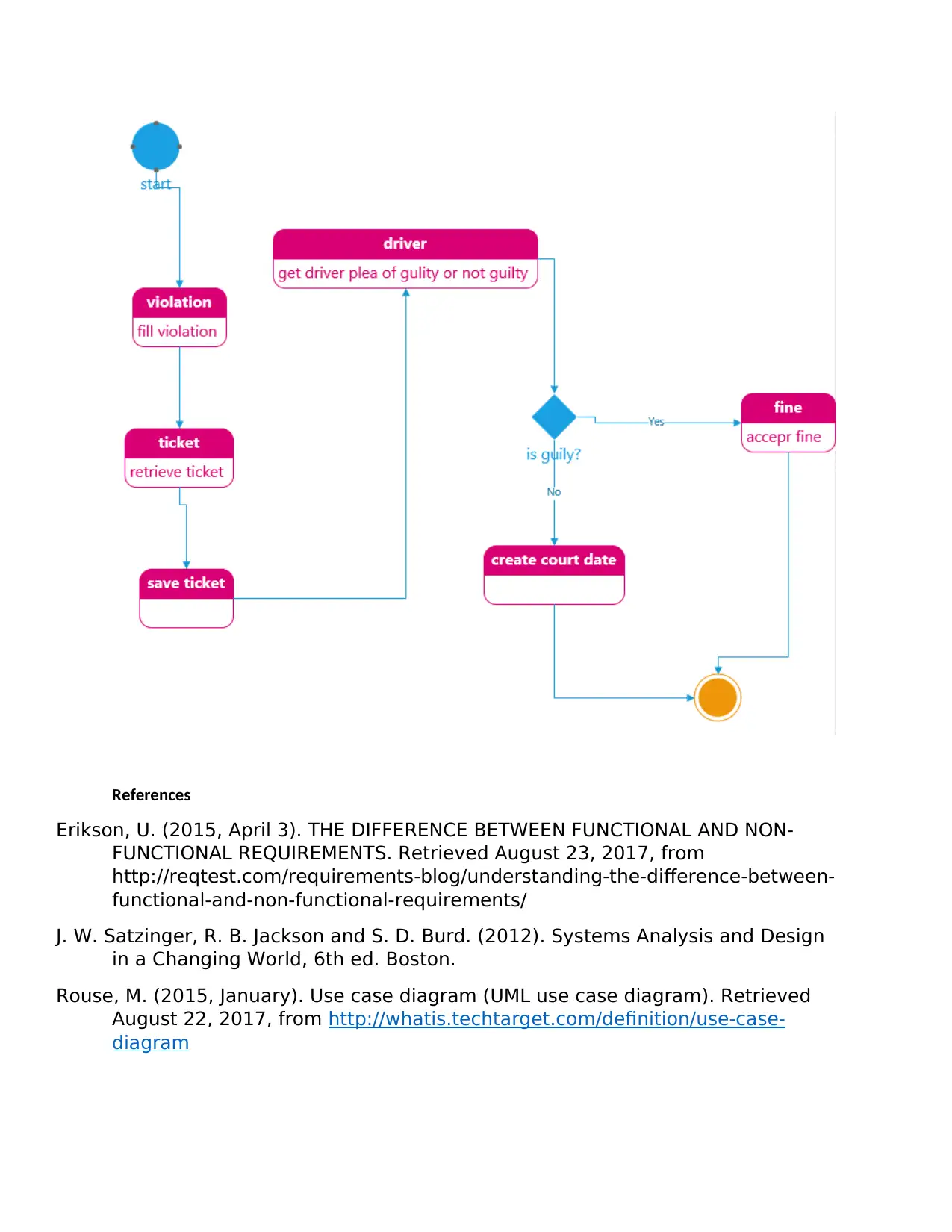
References
Erikson, U. (2015, April 3). THE DIFFERENCE BETWEEN FUNCTIONAL AND NON-
FUNCTIONAL REQUIREMENTS. Retrieved August 23, 2017, from
http://reqtest.com/requirements-blog/understanding-the-difference-between-
functional-and-non-functional-requirements/
J. W. Satzinger, R. B. Jackson and S. D. Burd. (2012). Systems Analysis and Design
in a Changing World, 6th ed. Boston.
Rouse, M. (2015, January). Use case diagram (UML use case diagram). Retrieved
August 22, 2017, from http://whatis.techtarget.com/definition/use-case-
diagram
Erikson, U. (2015, April 3). THE DIFFERENCE BETWEEN FUNCTIONAL AND NON-
FUNCTIONAL REQUIREMENTS. Retrieved August 23, 2017, from
http://reqtest.com/requirements-blog/understanding-the-difference-between-
functional-and-non-functional-requirements/
J. W. Satzinger, R. B. Jackson and S. D. Burd. (2012). Systems Analysis and Design
in a Changing World, 6th ed. Boston.
Rouse, M. (2015, January). Use case diagram (UML use case diagram). Retrieved
August 22, 2017, from http://whatis.techtarget.com/definition/use-case-
diagram

Subramanian, A. (2000). System Analysis. Retrieved 25 July 2017, from
https://theses.lib.vt.edu/theses/available/etd-09012000-16240054/unrestrict
ed/06Chapter4.pdf
https://theses.lib.vt.edu/theses/available/etd-09012000-16240054/unrestrict
ed/06Chapter4.pdf
⊘ This is a preview!⊘
Do you want full access?
Subscribe today to unlock all pages.

Trusted by 1+ million students worldwide
1 out of 12
Related Documents
Your All-in-One AI-Powered Toolkit for Academic Success.
+13062052269
info@desklib.com
Available 24*7 on WhatsApp / Email
![[object Object]](/_next/static/media/star-bottom.7253800d.svg)
Unlock your academic potential
Copyright © 2020–2025 A2Z Services. All Rights Reserved. Developed and managed by ZUCOL.





